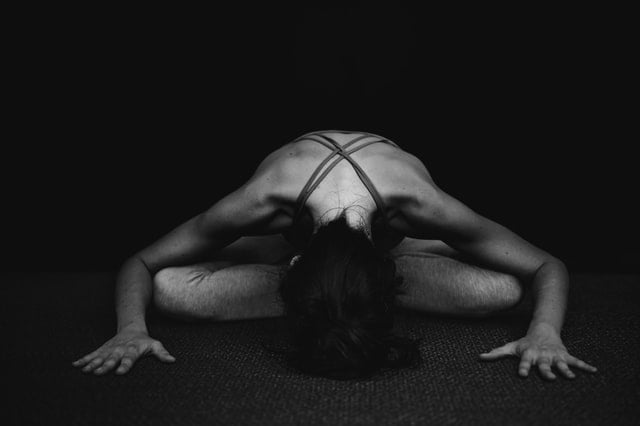“Breathe in peace and love, and exhale happiness,” the yoga teacher sang from the front of the class as we began.
Truthfully, though, having just endured a rough morning getting my “spirited” daughters off to school, I was nowhere in the emotional vicinity of love and happiness.
“Let it go,” a voice in my head reminded me. “Be in the moment.”
Back then, I proudly wore the label of yogini, not only in name but in practice and lifestyle. So that morning, I tried to “yoga” my way around my feelings—something we now rightly call spiritual bypassing—by attempting to inhale love and light through my ragged, tired body.
Because that’s what I thought “spiritual” people did. Because modern spiritual practice often leads us to believe the path to happiness is through ignoring everything else we are feeling and sensing. Because, when I studied pictures of yogis and yoginis in magazines, they looked like the bliss I coveted.
“Let go of negative thoughts” sounds simple. But while we’re pretending they don’t exist, those negative thoughts are lying in wait for a more vulnerable time to accost us — a time when, perhaps, we are not surrounded by others who could help us navigate through them.
My biggest fear back then was someone saying to me or thinking of me, “That’s not very yogic of you.” So with willpower fueled by fear and shame, I held myself together and forced myself to act in a way that ran contrary to how I felt. I left the class feeling more conflicted and upset than before.
The Mindset Adjustment
In its most untainted form, spiritual practice can help us grow into our personal authority and authenticity. It can encourage us to find our voice and access our deepest truths. It can deepen our connection to the earth as we deepen our connection to ourselves.
It’s always held this power. It can do these things still today.
Yet, spiritual centers and yoga studios today are designed for calm tranquility, not for messy awakenings or emotional outbursts. While I wouldn’t call them cults, there is no doubt a groupthink mentality —especially in those classes led by famous or popular teachers. We never disagree with or challenge the teachings, we keep a smile on our face, we remain attentive and complimentary, and we definitely don’t judge.
To put it more bluntly: modern interpretations of spiritual teachings are not encouraging us to be like Gandhi; they’re showing us, especially women, how to fit in on the set of “Stepford Wives.”
This is about more than just asking for a proper acknowledgment of my bad morning. It’s more than a group of students all googly-eyed over the presence of a famous teacher (guilty as charged). It’s more than all of this.
It’s about what the Hermetic tradition has taught human beings from our earliest human history: “As above, so below.”
This translates to these truths:
If we aren’t honoring the individual, we cannot honor the collective.
If we can’t see the whole individual, then we cannot see the whole collective.
No change for the individual, no change for the collective.
On the other hand: if we can free the individual, we can free the collective.
Societal Impact and Tipping Points
A tipping point is the point at which the collective consciousness (the status quo) shifts, expands, and rises to accommodate a new, higher vibration of what was originally a minority opinion. This is when an entire culture takes a giant evolutionary step forward. This is how ideas go global (or viral) and become common knowledge across continents. Ending indoor smoking, supporting gay marriage, and even the popularity of “mom jeans” are examples of such collective shifts.
Scientific American, The Atlantic, and Psychology Today suggest that 25 percent of the population needs to believe in a new idea before the entire society “tips” (i.e., embraces the new idea). Other studies suggest that the tipping point is less than that, perhaps just 10 percent of the population.
According to Statistica, 55 million people practice yoga in the United States alone. Some back-of-the-napkin math puts that at roughly 17 percent of the population—more than the lower estimate needed to change the collective and nearing the upper estimate.
Here’s the question that keeps me tossing and turning at night: if 17 percent of the American population is practicing yoga, why don’t we see a notable impact? Why are concepts such as compassion, oneness, and authenticity not making a bigger dent in the dog-eat-dog, consumeristic, individualist society?
If we look closer, I think we can argue that not only does the yoga community make little impact on the culture, the impact flows in the opposite direction:
>> Society doesn’t talk about pain, so neither does the yoga community.
>> Society doesn’t accept anger as a valid emotion, and neither does the yoga community.
>> Fear, shame, and guilt are to be denied and pushed through rather than honored in both the society at large and the yoga community.
>> Society demands we suppress our authenticity to belong or survive, and so does the yoga community.
>> Society teaches us how to gaslight ourselves into pretending we’re feeling something we’re not, while giving us tools to bypass these feelings. And so does the yoga community.
The reason we’re not feeling the impact of the 17 percent practice rate is that modern yoga and spiritual practices have absorbed the core principles of society. Over time (and without putting up much of a fight, because money) the bubbling hot transformative power of spirituality has diluted into lukewarm bathwater.
We’re practicing yoga, but we’re still denying emotions instead of embodying them. We’re studying spirituality, but we’re still detached from our power rather than claiming it. We say we’re living authentically, but we still struggle in silence with shame and desire.
And we gaslight ourselves into believing that this is what being “spiritual” is all about, even though it’s more of the same.
Modern-day yoga and spiritual practices have become about “adjusting our mindset” in such a way that we slowly adapt to the circumstances of the world, rather than impacting the world as Gandhi suggested we do when he asked us to “be the change.”
Reclaiming Yoga and Spirituality as Agents of Change
At its heart, yoga is a radical and even rebellious practice—one that was never supposed to be about the body alone. In fact, the body was always supposed to merely mirror a much larger transformative process. (I had one fabulous teacher who taught that as we deepened and refined our postures, it was merely reflecting the more critical movement we were doing in our lives and minds.)
But as it stands, we not only “breathe in peace” to hide our bad mornings, we “breathe in peace” to hide from facing global poverty, climate change, a dangerous assault on our nation’s capital, rising fascism around the world, systemic racism, corrupt policing, and so much more.
The “mindset adjustments” that we practice in yoga do not make us or the world healthier, but rather serve to help us adapt to worsening conditions in our world.
We deny anger that could be channeled into activism.
We force grief and sorrow into acceptance too quickly out of fear of being deemed “unyogic” or “unspiritual.”
And we sit back, smile, nod, and agree—even in times when we should be getting on the front lines, disagreeing, and fighting for issues that matter to us.
We must free these potent practices from the clutches and influences of the status quo.
Spirituality can either be one of the most powerful forces on Earth, or it can be nothing more than a facade, unknowingly providing an echo chamber for the status quo.
Yoga and spiritual communities can and should be energies of revolution and societal change, as renowned yoga teacher Sean Corne teaches. And spiritual practice should be nothing less than wholehearted sacred activism, as Andrew Harvey teaches.
As Harvey himself says:
“A spirituality that is only private and self-absorbed, one devoid of an authentic political and social consciousness, does little to halt the suicidal juggernaut of history.”
Spiritual communities should be sanctuaries in which we can open up to our deepest selves. They should be places where we can reveal and heal our deepest wounds—not by bypassing or gaslighting, but by authentic and clear-eyed work.
As we grow in our understanding of ourselves, and as we connect more potently to who we are, we will fall in love with humanity and the world—not fall away from it. Then, wild devils couldn’t keep us away from becoming agents of radical change and transformative power in this world we love so much.
If anyone has the tools to be shaping and reshaping the world, leading with wisdom, compassion, and calm abidance, it’s a spiritual practitioner.
If anyone understands the slowly-and-then-all-at-once way that paradigms shift, it’s someone who has seen their spiritual growth unfold in such a way.
Spiritual practitioners can be the difference-makers and paradigm-tippers the world needs. We can lead with open hearts and active compassion. And we do so by starting from where we are, not from some imagined future or long-ago place.
This begins with offering alternative openings and cues like this one:
“Breathe into wherever you’re feeling emotion in your body right now. Let it expand, and let it speak. Breathe out, and remember that all human beings feel this way sometimes. Because we are all the same in the ways that matter.”
While it might not seem like making such small changes in a yoga class could make such a big difference, the philosophy of tipping points tells us that’s exactly how big things happen.
But, it is going to require more than a mindset adjustment.
~


 Share on bsky
Share on bsky





Read 31 comments and reply